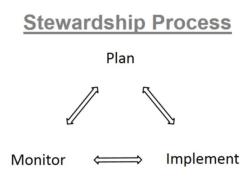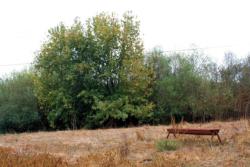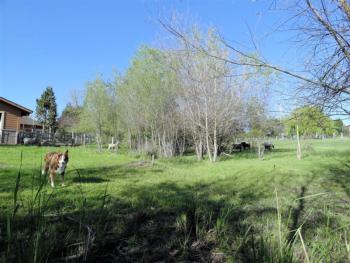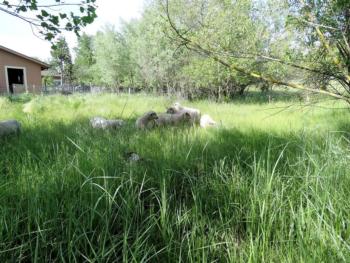Ranch Planning and Conservation Monitoring
A focus area of the Watershed Management Program, the Ranch Planning & Conservation Monitoring Coordinator applies lessons learned from previously completed restoration projects and conservation practices to assist landowners in prioritizing their stewardship plans on their ranches and farms.
Based on long-term outcomes, future conservation and restoration approaches are discussed to balance tradeoffs that avoid undesired consequences and increase project success to meet objectives for improving ranch/farm productivity, water quality, wildlife habitat, Carbon sequestration, groundwater infiltration, etc.
Options for Riparian Areas
Michael Lennox, UCCE Ranch Planning & Conservation Monitoring Coordinator, October 2013
Decisions to preserve, conserve and restore sensitive locations on our ranches are not taken lightly. Efforts to maintain and improve riparian vegetation have provided valuable insights into the long-term recovery of streams and watersheds across the United States with over $2 billion spent in California since the 1980s. To learn from past projects, I battled the hemlock and blackberry thickets to survey and research restored streams (article). Riparian areas are the transitional area of land along waterways between dry and wet locations. They are very important for ranch productivity and watershed management. This article describes how monitoring of previous riparian restoration efforts helps to prioritize stewardship and conservation for your ranch so you have more tools to manage vegetation when you want alternatives.
We have learned that numerous options are viable to successfully improve or maintain riparian areas, depending on ranch location and specific management objectives (report). Our results highlight the importance of time for vegetation to establish and grow in order to evaluate restoration project success and long-term outcomes (article).

In addition to environmental considerations are practical concerns about ranch operations and logistics to ensure time is not wasted and animals will be healthy for many years to come. Riparian restoration methods used with success on ranches were: control the timing and duration of riparian grazing by fencing riparian corridors within existing pastures, fence riparian areas to exclude livestock, change the kind and class of livestock, reduce duration of grazing, reduce grazing intensity and control season of use (report). We learned that completely removing livestock was not the best or only solution for every site. As a result, the “lock it up and throw away the key” approach is an oversimplification of our ecological reality – it assumes nature heals itself the way we want it to, but this is blind optimism (article).
The nexus of environmental and operational concerns on each ranch guides where to prioritize conservation, restoration and stewardship efforts. Experience and research has shown that restoration projects are more successful when landowners are vested and want it done (report). During the planning phase of projects, consider multiple options that would provide slow vs. fast revegetation trajectories and these are often cheap vs. more expensive approaches. In general, the more money spent on restoration, the greater the environmental benefits; however, this is not often a linear relationship – some conservation practices have a larger ‘bang for the buck’ depending on the site and management priorities. For example, installing water trough(s) improve water quality, as well as animal health, by reducing duration and intensity of grazing near the stream (fact sheet); however, at a site with headcuts where the channel is down cutting to cause bank erosion, more practices are included such as grade stabilization structure, control fencing and/or revegetation (publication).
More Information
Microbial Water Quality Information Center
Sonoma Creek and Napa River Watersheds’ Ranch Water Quality Plans
Tomales Bay Watershed Ranch Water Quality Plans
Groundwork: a handbook for small-scale erosion control in coastal Ca (2nd link)
Riparian Management Practices CEAP (chapter 5) pdf
Conservation Benefits of Rangeland Practices CEAP: Assessment, Recommendations, and Knowledge Gaps
Factors and Practices that Influence Livestock Distribution
Water Troughs for Water Quality (FS #20)
Residual Dry Matter (RDM)
Maintaining Wood in Streams: A Vital Action for Fish Conservation
Resources for Ranch Water Quality Plans
Contrary to Popular Belief: anti-cow activists in Ca who have changed perceptions
Hope in Conservation and Restoration
Rangeland Watershed Management Measures and Practices (FS #9)
Hurdles and Opportunities for Landscape-Scale Restoration
Riparian Pasture Options (FS #19)

Luckily, livestock grazing is compatible with riparian forests (publication) and certain trees are more resistant to disturbance than others. For example, taller tree species with upright growth, such as this 15-year-old box elder (Acer negundo), are able to compete with arroyo willow (small trees), need less maintenance, and use less water (photo 1). Other tall, canopy-forming tree species include Pacific willow (Salix lucida), Fremont cottonwood (Populus fremontii) and Oregon ash (Fraxinus latifolia). I recommend using multiple species that are appropriate for your site.
|
“Cattle tend to concentrate in a riparian area if (1) water is not well distributed, (2) the land near riparian water is steep or rocky (especially if all the water is riparian, (3) salt is placed in or near riparian areas, (4) the weather is hot and riparian shade is available, (5) non-riparian forage is less palatable than riparian forage, (6) the herd is composed of cows with calves as opposed to yearlings, (7) individual animals develop behavior patterns that favor riparian areas, (8) animal distribution is not maintained by herding, and/or (9) the grazing season is long.” Riparian Pasture Options (fact sheet 19) |

| “There have been many examples of spectacular conservation success, given the right set of circumstances and opportunities. This is where restoration comes to the fore, and provides the possibility of reversing past damage—in other words, turning loss into gain….The hope provided by restoration does, however, have to be realistic, and to be based on the reality of the situation. Blind optimism can lead to false promises, wasted effort, and poor outcomes, particularly if expectations exceed capabilities…. This is hope with its sleeves rolled up – not as an emotional buffer against cold hard facts but as a stoic, clear-eyed and utilitarian alternative to apathy, inaction and despair…. Hope is not blind optimism; it recognizes the depth of the problem and refuses to accept defeat. It is not a feeling – it is a choice.” Grieving for the past, hoping for the future |
Remember, the slow approach using incremental steps is a completely viable option. Evaluating the effectiveness of stewardship efforts is often a very rewarding process as lessons learned provide direction, pride and confidence. Please contact me for more information about monitoring or prioritizing your projects mlennox@ucdavis.edu 707.565.2621.
An upland swale near Santa Rosa with young restored riparian habitat nine years after tree planting (box elder, ash, cottonwood, willow, oak), headcut repair and sediment/infiltration basins were completed. Lambs and ewes finished grazing during a dry spell in early spring (Photo 2) to optimize forage nutrition, avoid impacts to trees, control blackberry encroachment and reduce competition from invasive medusahead and harding grass. Regrowth less than a month later (Photo 3) indicates the productivity of riparian areas and their importance to sustaining healthy animals on this ranch.

Photo 2
|

Photo 3
|

